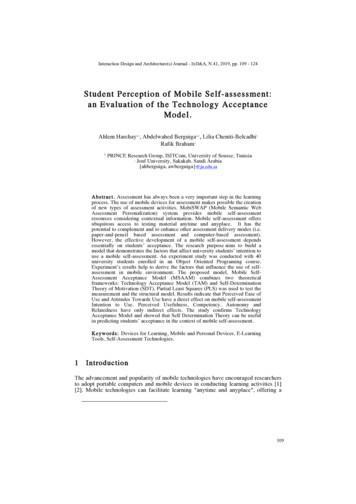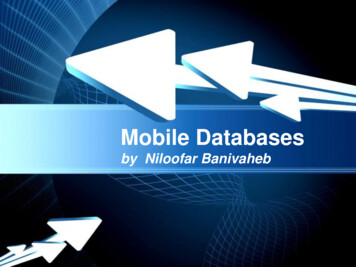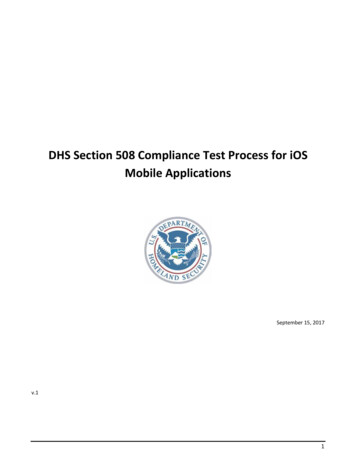
Transcription
Interaction Design and Architecture(s) Journal - IxD&A, N.41, 2019, pp. 109 - 124Student Perception of Mobile Self-assessment:an Evaluation of the Technology AcceptanceModel.Ahlem Harchay , Abdelwahed BerguigaRafik Braham1,21,2, Lilia Cheniti-Belcadhi111PRINCE Research Group, ISITCom, University of Sousse, TunisiaJouf University, Sakakah, Saudi Arabia{ahberguiga, awberguiga}@ju.edu.sa2Abstract. Assessment has always been a very important step in the learningprocess. The use of mobile devices for assessment makes possible the creationof new types of assessment activities. MobiSWAP (Mobile Semantic WebAssessment Personalization) system provides mobile self-assessmentresources considering contextual information. Mobile self-assessment offersubiquitous access to testing material anytime and anyplace. It has thepotential to complement and to enhance other assessment delivery modes (i.e.paper-and-pencil based assessment and computer-based assessment).However, the effective development of a mobile self-assessment dependsessentially on students’ acceptance. The research purpose aims to build amodel that demonstrates the factors that affect university students’ intention touse a mobile self-assessment. An experiment study was conducted with 40university students enrolled in an Object Oriented Programing course.Experiment’s results help to derive the factors that influence the use of selfassessment in mobile environment. The proposed model, Mobile SelfAssessment Acceptance Model (MSAAM) combines two theoreticalframeworks: Technology Acceptance Model (TAM) and Self-DeterminationTheory of Motivation (SDT). Partial Least Squares (PLS) was used to test themeasurement and the structural model. Results indicate that Perceived Ease ofUse and Attitudes Towards Use have a direct effect on mobile self-assessmentIntention to Use. Perceived Usefulness, Competency, Autonomy andRelatedness have only indirect effects. The study confirms TechnologyAcceptance Model and showed that Self Determination Theory can be usefulin predicting students’ acceptance in the context of mobile self-assessment.Keywords: Devices for Learning, Mobile and Personal Devices, E-LearningTools, Self-Assessment Technologies.1IntroductionThe advancement and popularity of mobile technologies have encouraged researchersto adopt portable computers and mobile devices in conducting learning activities [1][2]. Mobile technologies can facilitate learning "anytime and anyplace", offering a109
Interaction Design and Architecture(s) Journal - IxD&A, N.41, 2019, pp. 109 - 124continuous learning experience that is personal, situated and contextual [3]. Handlingmobile devices in education have emerged new forms of learning and assessingsystems [4][5][6]. All educational processes can be facilitated even revitalizedthrough mobile technologies [7].Self-assessment in an educational setting involves students making judgmentsabout their own work. Students can make assessment decisions regarding their ownessays, performances, dissertations and even exams [8].Recently, mobile technologies have been used in assessment. Mobile assessment isa new delivery mode of assessment that offers ubiquitous access to testing materialanytime and anyplace. Due to its mobile features, it has the potential to complementand enhance other assessment delivery modes i.e. paper-and-pencil based orcomputer-based assessment [9]. A variety of mobile assessment types can bedistinguished: self-assessment, peer-assessment, adaptive assessment, context-awareassessment, game-based assessment. All these types can be implemented usingmobile devices [10].Mobile self-assessment can be used both in formal and informal settings [11]. Inthe context of formal setting, the usage of mobile devices like smartphones increasesstudent attention and engagement. In the context of informal setting when studentshave more control over their assessment goals and process, mobile self-assessmentcan be particularly beneficial [12]. In fact, students think that mobile devices wouldallow them to execute self-assessment test activities during their spare time (forinstance while traveling or waiting for public transport, etc.). In this way, they canself-assess and better prepare for an exam when they cannot use a PC.Considering the increased use of mobile assessment, researchers try to identify thefactors that affect learners to use in order to implement it successfully. In fact, thelarge field of possible educational settings and application areas where mobile selfassessment can be applied makes important to investigate its user adoption.Technology acceptance models help to improve the system’s implementation. In fact,the determination of factors influencing the use or the adoption of a system by its endusers makes possible to ameliorate his implementation. The modification of certainfunctionalities still also possible making the system more suitable and moreappropriate to the users’ expectations.A literature review clarifies that there are many studies examining the acceptanceof computer-based assessment [8][13] and others for the acceptance of mobilelearning [14][15][16]. But, the determination of the factors that influence theacceptance of mobile self-assessment remains little studied [40] [41].In the present study, we try to justify and to prove which factors affect theuniversity students’ acceptance and intention to use of mobile self-assessment. Thepresent study combines two theoretical frameworks: Technology Acceptance Modeland Self-Determination Theory of Motivation. Partial Least Squares were used to testthe hypothesized relationship among the variables in the model.The rest of this paper is organized as follows; the next section describes the mostrelated previous research works on mobile learning and mobile assessment. After theliterature review, the methodology and the results of the proposed research model aredescribed. Thereafter, results are discussed as well as conclusions are presented.2Theoretical BackgroundIn recent years, mobile learning is of major use especially with the large evolution ofmobile technologies. But, the use of mobile technology for assessment especially informal setting (e.g. final exam degree) remains some limitation. In fact, mobiledevises’ users feel anxious when they mobile technologies for assessment. To ensure110
Interaction Design and Architecture(s) Journal - IxD&A, N.41, 2019, pp. 109 - 124its successful use in an academic context, we determine its acceptance’s degree andadoption by university students. Mobile self-assessment can be attributed to severaleffective factors: personal, social or level of technology.Before exploring the mobile self-assessment acceptance factors, foundations oftheories and previous study on technology adoption has been explored. A number oftheories have been explored to explain the concept of technology acceptance: theTheory of Reasoned Action (TRA) [17], the Theory of Planned Behavior (TPB) [18],the Innovation Diffusion Theory (IDT) [19] and the Technology Acceptance Model(TAM) [20]. TAM is the most dominant model regarding technology acceptance. Itfocuses on two particular constructs of perceived usefulness and perceived ease of useas drivers of technology acceptance. Perceived ease of use and perceived usefulnesspredict attitude towards use of a technology. Then, attitude towards use predicts theintention to use indicating the actual acceptance of a technology [21]. In summary,TAM in its original formulation as specified by Davis [20] includes four concepts:ease of use, usefulness, attitude towards use and intention to use as show in Fig. 1.Fig.1. Technology acceptance Model [20]The TAM is a very useful theoretical model that has been tested in manyempirical studies. In the educational field, TAM is used as a tool to determine thedegree of students’ learning acceptance.Students’ perceptions of mobile self-assessment need to be investigated at theinitial step of implementing mobile assessment in higher education. Therefore, it isnecessary to conduct research that identifies factors that university students considerimportant in the acceptance of mobile self-assessment. Some studies haveinvestigated the acceptance of mobile learning and computer based-assessment usingTAM. However, a limited number of studies have investigated the acceptance ofmobile assessment [9] [10] [41] [42]. Therefore, there is a need to clarify the effect ofmobile devices experience on the acceptance of assessment.In the following, we explain how TAM has been addressed respectively in,mobile learning, web based computer assessment and mobile assessment. Ourobjective is to understand the factors driving respectively, mobile learning, webbased-assessment and mobile assessment adoption using TAM.2.1 TAM and mobile learningTAM has been successfully used as a framework to study learner’s acceptance ofmobile learning. The general structural model elaborated by [14] is based on theTAM. The research model consists of eight constructs including: mobile learning self-111
Interaction Design and Architecture(s) Journal - IxD&A, N.41, 2019, pp. 109 - 124efficacy, relevance for students’ major, system accessibility, subjective norm,perceived usefulness, perceived ease of use, mobile learning attitude, and behavioralintention to use mobile learning. The study results confirmed the acceptability of themodel to explain students’ acceptance of mobile learning. Mobile earning attitudeforms the most important construct in explaining the causal process in the model.The study [15] integrates perceived enjoyment from the motivational model andperceived mobility value as an external variable of perceived usefulness to explainand to predict the acceptance of mobile Learning. The findings results show thatperceived usefulness and perceived ease of use influence positively and significantlystudents’ attitude towards use mobile learning. In addition, Attitude positively andsignificantly affects intentions to use mobile learning. Results also indicate thatindividual differences have a great impact on user acceptance and that the perceivedenjoyment and perceived mobility can predict user intentions to use mobile learning.Liu et al. developed also a conceptual model to examine factors affecting theadoption intention of mobile learning [16]. Their findings indicate that perceivedusefulness and personal innovativeness have significant influence on mobile learningacceptance. Personal innovativeness is a predictor construct of both the perceivedease of use and perceived usefulness.Including subjective norm and individual differences Wei-Han et al. developed aconceptual model to examine factors affecting the acceptance of mobile learning inMalaysia [22]. Findings indicate that perceived usefulness, perceived ease of use, andsubjective norm are positively associated with intention to adopt mobile learning.Further, gender factor did not show significant effect on intention towards mobilelearning usage in their study.2.2 TAM and computer based-assessmentThe effective development of a computer based assessment depends essentially onstudents’ acceptance. There are numerous studies examining the acceptance ofcomputer based-assessment using TAM.The study proposed by Terzis and Economides aims to build a model thatdemonstrates the constructs that affect students’ behavioral intention to use acomputer based-assessment [8]. The proposed model, Computer Based AssessmentAcceptance Model (CBAAM) is based on TAM, Theory of Planned Behavior TPB(TPB) and the Unified Theory of Acceptance and Usage of Technology (UTAUT).Constructs such as Perceived Usefulness, Perceived Ease of Use, Computer SelfEfficacy, Social Influence, Facilitating Conditions and Perceived Playfulness areused. Additionally, two new variables, Content and Goal Expectancy, were added tothe proposed research model. Results indicate that Perceived Ease of Use andPerceived Playfulness have a direct effect on computer based-assessment use.Perceived Usefulness, Computer Self Efficacy, Social Influence, FacilitatingConditions, Content and Goal Expectancy have only indirect effects.In another study using TAM, Terzis and Economides aim to explore thecontinuance acceptance in computer based assessment and the development of a newapproach for continuance use [13]. The approach is applied by measuring user’sexpectations before the interaction with the system and user’s perceptions after theinteraction. Results underline Confirmed Ease of Use and Confirmed Playfulness asthe direct determinants of continuance acceptance.The user’s acceptance of Computer Based Assessment Systems is examined withthe help of the Computer Based Assessment Acceptance Model (CBAAM) in the twodifferent cultures of Greece and Mexico [23]. The study was conducted by deliveringthe same computer based-assessment system to students of identical courses in Greeceand Mexico. The results indicate that the CBAAM is valid for both countries in112
Interaction Design and Architecture(s) Journal - IxD&A, N.41, 2019, pp. 109 - 124overall. However, there are some cultural differences. Greek students’ behavioralintention is triggered mainly by Perceived Playfulness and Perceived Ease of Use,while Mexican students’ behavioral intention is caused by Perceived Playfulness andPerceived Usefulness.Table 1. RELATED WORKS AND MAINLY OBTAINED RESULTSResultsStudyTAM and mobile learning[14][15][16][22]Mobile learning Attitude forms the most importantconstruct in explaining the causal process in modelPerceived usefulness and perceived ease of useinfluence students’ attitude towards use mobilelearning. Mobile learning Attitude affectsintentions to use mobile learning.Perceived usefulness and personal innovativenesshave significant influence on mobile learningacceptance. Personal innovativeness is a predictorconstruct of both the perceived ease of use andperceived usefulness.Perceived usefulness, perceived ease of use andsubjective norm are positively associated withintention to adopt mobile learning.TAM and web basedcomputer assessment[8][13][23]Perceived Ease of Use and Perceived Playfulnesshave a direct effect on CBA use. PerceivedUsefulness, Computer Self Efficacy, SocialInfluence, Facilitating Conditions, Content andGoal Expectancy have only indirect effects.Confirmed Ease of Use and Confirmed Playfulnessare the direct determinants of continuanceacceptance.The CBAAM is valid for both countries. Greekstudents’ behavioral intention is triggered mainlyby Perceived Playfulness and Perceived Ease ofUse, while Mexican students’ behavioral intentionis caused by Perceived Playfulness and PerceivedUsefulness.TAM and mobileassessment[9][41]Perceived Autonomy, Perceived Relatedness andPerceived Competency, along with PerceivedUsefulness and Perceived Ease of Use, influenceAttitudes Towards Use and Behavior Intention touse Mobile-Based Assessment.The proposed model explains and predictsstudents’ intention to use mobile based assessmentin terms of both acceptance and motivational(autonomy, competence and relatedness) factors.113
Interaction Design and Architecture(s) Journal - IxD&A, N.41, 2019, pp. 109 - 1242.3 TAM and mobile assessmentA bibliographic research survey on mobile assessment and TAM’s use reports thefollowing research works. Nikou and Economides examine the factors that influencethe acceptance of mobile-based assessment [9]. The proposed model combines twotheoretical frameworks: Technology Acceptance Model and Self-DeterminationTheory of Motivation. Perceived Autonomy, Perceived Relatedness and PerceivedCompetency, along with Perceived Usefulness and Perceived Ease of Use, influenceAttitudes Towards Use and Behavior Intention to use mobile-based assessment. Thestudy confirms Technology Acceptance Model and showed that Self DeterminationTheory can be useful in predicting students’ acceptance in the context of mobilebased assessment. In [41], authors propose a study build on the theoretical frameworkof the Self-Determination Theory of Motivation and the Technology AcceptanceModel and propose the Mobile Based Assessment - Motivational and AcceptanceModel (MBA-MAM), a combined model that explains and predicts BehavioralIntention to Use Mobile-based.Table I summarizes the cited related works used later to develop our proposedmodel and illustrates mainly obtained results.This study combines two theoretical frameworks: Technology Acceptance Modeland Self-Determination Theory of Motivation to develop a model of mobile selfassessment acceptance that would help educators to identify the factors that influencethe technology acceptance.3 Methodology and Gathering Techniques3.1 SystemA mobile self-assessment system MobiSWAP (Mobile Semantic Web AssessmentPersonalization) built for a previous experiment [6] was adjusted to serve the needs ofthe current study. The purpose of this study is to determine factors influencing theacceptance of mobile self-assessment as it is described and provided by MobiSWAP.In [6], the basic functionalities of MobiSWAP were tested by university’s students.MobiSWAP includes basic functions providing learners with appropriate mobileself-assessment resources considering contextual information (used device, place,time, learner’s level).The system allows generating assessment tests based on context information andpersonalized to student profile. It is based on Web services and semantic Webtechnologies [24]. MobiSWAP operates a set of ontological models [25] [26]. Thesystem is based on an assessment resources retrieval algorithm. The algorithm allowsto personalize assessment tests to the learner profile and to adapt to the context [27].3.2 Research model and hypothesesThe MSAAM (Mobile Self-Assessment Acceptance Model) was applied to universitystudents in order to examine the acceptance and the use of self-assessment to improvelearning in mobile situation. This section describes the MSAAM’s variables andhypotheses.The proposed research model combines two theoretical frameworks: TechnologyAcceptance Model and Self-Determination Theory of Motivation [28]. According tothe Self-Determination Theory of Motivation theory, a basic set of psychological114
Interaction Design and Architecture(s) Journal - IxD&A, N.41, 2019, pp. 109 - 124needs must be satisfied in order to enhance intrinsic motivation. These needs areautonomy, competence and relatedness [9]. We assume that perceived autonomy (A),perceived competence (C) and perceived relatedness (R) form the three externalvariables in our proposed research model, MSAAM.Autonomy reflects the learners’ desire to self-initiate and self-regulate their ownbehavior. In mobile environments, learners have a strong sense of mobile devices’ownership. This sense can be transformed to a learning property. Similarly, thecontrol of the assessment process is considered among the motivation factors in amobile context. Therefore, the various self-regulation and property factors can beconceptualized as a perceived autonomy (A). Therefore, we assume the followinghypothesis:H1. University students’ perceived Autonomy (A) when using mobile devices to selfassessment will have a positive influence on the mobile self-assessment PerceivedUsefulness (PU).Competence refers to the desire to feel effective in attaining valued outcomes[28].It refers to human needs to achieve effective results. The majority of learnershave a convenience to use mobile devices to complete some activities such as Webnavigation. Learning activities such as mobile self-assessment can be perceived as anexperience that improves learner’s skills in mobile situations. Therefore, we haveconsequently established the following hypotheses:H2. University students’ perceived Competence (C) when using mobile devices toassessment will have a positive influence on the mobile self-assessment PerceivedUsefulness (PU).H3. University students’ perceived Competence (C) when using mobile devices toassessment will have a positive influence on the mobile self-assessment PerceivedEase of Use (PEOU).Relatedness refers to the human need to feel connected and affiliated to other of hisenvironment. The use of mobile devices provides rich social interaction allowingusers to collaborate and to share information. Therefore, we propose the followinghypothesis:H4. University students’ perceived Relatedness (R) when using mobile devices toassessment will have a positive influence on the mobile self-assessment PerceivedUsefulness (PU).Perceived Usefulness (PU) presents the degree to which a user considers that usinga specific system/technology will improve his/her performance [20]. Therefore, wehypothesized:H5. University students’ Perceived Usefulness (PU) will have a positive effect onAttitudes Towards Use (ATU) mobile self-assessment.H6. University students’ Perceived Usefulness (PU) will have a positive effect onIntention to Use (ITU) mobile self-assessment.Perceived Ease of Use (PEOU) constitutes the degree to which a user considersthat using a system would be free of effort [20]. Mobile learning and assessmentacceptance models showed that the Perceived Ease of Use (PEOU) influencespositively and directly the Perceived Usefulness (PU), the Attitudes Towards Use(ATU) and the Intention to Use (ITU) [29] [30].Therefore, we present the followingthree hypotheses:H7. University students’ Perceived Ease of Use (PEOU) will have a positive effecton Attitudes Towards Use (ATU) mobile self-assessment.H8. University students’ Perceived Ease of Use (PEOU) will have a positive effecton Intention to Use (ITU) mobile self-assessment.H9. University students’ Perceived Ease of Use (PEOU) will have a positive effecton Perceived Usefulness (PU) mobile self-assessment.The degree to which a user is interested to a specific system/technology is the115
Interaction Design and Architecture(s) Journal - IxD&A, N.41, 2019, pp. 109 - 124Attitude Towards Use (ATU) [20]. ATU influences positively and directly theIntention to Use (ITU). Therefore, we hypothesized:H10. Attitudes Towards Use (ATU) will have a positive effect on Intention to Use(ITU) mobile self-assessment.Respecting the previously hypotheses, we propose the following mobile selfassessment conceptual model (Fig.8).Fig.2. Mobile self-assessment conceptual model.3.3 Data collectionThe survey study was conducted with university students, enrolled in an OOP (ObjectOriented Programing) course, in a Tunisian University, Higher Institute of ComputerScience and Management of Kairouan, in Tunisia. The participation in the procedurewas voluntary. 40 computer sciences students, 27 having intermediate level in OOPcourse (67.5%) and 13 having beginner level (32.5%) are concerned in the procedure.Students have already completed a first experimentation to evaluate thepersonalization and adaptable MobiSWAP system’s functionalities [6].3.4 InstrumentThe objective of the following experiment is to test the acceptance of mobile selfassessment as an activity to improve and to enhance learning in mobile situations. Tothis end, the mixed evaluation method proposed by Martinez et al. [31] has beenselected due to the characteristics of the educational context including participants,used devices and learner’s place. The mixed method combines quantitative techniquesand sources, such as closed questions or event log files generated automatically by thesystem, with qualitative techniques, such as open-ended questions and first-handobservations [32]. To evaluate the case study according to the mixed method,students’ perceptions about the experiment were collected in a paper-basedquestionnaire delivered immediately after the first experiment [6]. The questionnaireoperationalizes different variables of our proposed research model (Appendix A).After the end of the procedure, 40 students have to answer the questionnaire survey(MSAAM) as illustrated in Appendix A. MSAAM consists of 24 items in order tomeasure its 7 latent variables (fig.8). To assess students’ perceived Autonomy (A)116
Interaction Design and Architecture(s) Journal - IxD&A, N.41, 2019, pp. 109 - 124support we have used 4 items. For perceived Relatedness (R) we used 3 items and forperceived Competency (C) we used 4 items. To assess Attitudes Towards Use (ATU)we have used 3 items. For the Intention to Use (ITU) we employed 4 items and for thePerceived Ease of Use we have used 3 items. Questions were adapted from previousstudies while making some changes reflecting the targeted technology in ourframework [33][34]. Some modifications of items were made in order to describe thecurrent research context mobile self-assessment. We used the seven point Likert-typescale with 1 "strongly disagree" to 7 "strongly agree", in order to measure theitems. To conclude, our measurement instrument consists of 24 items and ourresearch model consists of seven constructs (Appendix A).3.5 Data analysis and resultsTable 2. Results for the measurement model: convergent validityConstruct OU1PEOU2PEOU3PUPU1PU2PU3ITUITU1ITU2ITU3Mean (SD)FactorLoading( 0.7)5.333(1,600)Cronbacha ( 0.7)CompositeReliability ( 0.7)AVE ( 696)0.8370.9010.8385,034(1,414)0.8390.8480.854117
Interaction Design and Architecture(s) Journal - IxD&A, N.41, 2019, pp. 109 - 124The MSAAM research model was tested and analyzed using Partial Least Squares(PLS) [35] [38]. PLS was used as an analysis technique to predict factors influencingmobile self-assessment adoption. PLS is component-based and uses a least-squaresestimation procedure. It is more suitable for our research because it provides severaladvantages [8]: (1) fewer demands on residual distributions; (2) smaller sample; (3)wider number of constructs and/or indicators; (4) testing theories in early stages ofdevelopment and (5) better for prediction. Thereby, smartPLS3 (v.3.2.0) was used forthe analysis [37]. SmartPLS is one of the leading tools for practical least squaresstructural equation modeling.Reliability and validity for the measurement model are measured throughconvergent validity and discriminant validity [35] [38].Convergent and discriminantvalidity need to be verified in order to ensure the quality of the model. From astatistical point of view, convergent validity was examined for each construct by theverifying the following four criteria:1. All the indicators Factor Loadings should exceed 0.7.2. The Composite Reliability (CR) of each construct should exceed 0.7.3. The Average Variance Extracted (AVE) by each construct should exceed thevariance due to measurement error for that construct (AVE 0.5).4. The Cronbach Alpha (a) value of each construct should exceed 0.7 (a 0.7).Table 2 confirms the convergent validity. All the factor loadings of the items in themeasurement model exceed the demand value (0.7). Moreover, all CompositeReliability (CR) values range from 0.864 to 0.907 and the Average VarianceExtracted (AVE) values alter from 0.615 to 0.765 which exceed the adequate values,respectively (0.7 and 0.5).The consistence between different items is verified bycalculating the Cronbach Alpha (a) value which exceeds 0.7 for all constructs.Thereby, all criteria for convergent validity are satisfied.Discriminant validity is supported when the square root of the Average VarianceExtracted (AVE) of a construct is higher than any correlation with another construct.This means that a construct correlation with its indicators is higher than anycorrelation with another construct. Table 3 reports the square root of the averagevariance extracted of each construct (the diagonal elements are the AVE). All theAVE are greater than any other correlation. Consequently, the discriminant validity ofthe proposed research model is confirmed.SmartPLS3 was also used to examine the statistical significance of the relations inthe model. A boot strapping procedure was applied. The calculated R2 values, thesignificances of the path coefficients as well as the t-values and the total effects arethe criteria used to assess our structural model and its hypotheses.Table 3. Results for the measurement model: discriminant 0.6820.766PU0.8690.749R0.875The correlation coefficient measures the robustness of the relationship betweentwo variables.A correlation is significant if the (t-value) exceed 1.96. Positive correlationcoefficients close to 1 assume a strong correlation link while those who are close to118
Interaction Design and Architecture(s) Journal - IxD&A, N.41, 2019, pp. 109 - 1240 indicate a weak correlation link between constructs. Figure 3 and Table 4summarize the hypothesis testing results.We found support for seven out of ten hypotheses in our proposed model.Regarding the Perceived Usefulness, we find a direct positive effect of PerceivedAutonomy, Perceived Competency and Perceived Relatedness but no direct effect ofPerceived Ease of Use. Intention to Use has a direct positive effect on AttitudesTowards Use and Perceived Ease of Use but no direct effect of Perceived Usefulness.Attitudes Towards Use has a direct positive impact of Perceived Usefulness but nodirect effect of Perceived Attitudes Towards Usage. Finally, Perceived AttitudesTowards Use has no direct effect of Perceived Competency.Table 4. Results for the measurement model: discriminant validityHypothesisH1H10H3H2H7H8H9H5H6H4PathA !PUATU ! ITUC! PEOUC ! PUPEOU ! ATUPEOU ! ITUPEOU ! PUPU ! ATUPU ! ITUR ! YesNoYesReferring to
mobile learning, web based computer assessment and mobile assessment. Our objective is to understand the factors driving respectively, mobile learning, web based-assessment and mobile assessment adoption using TAM. 2.1 TAM and mobile learning TAM has been successfully used as a framework to study learner's acceptance of










